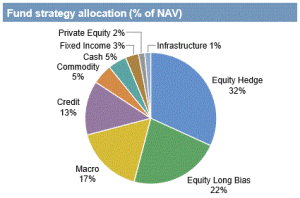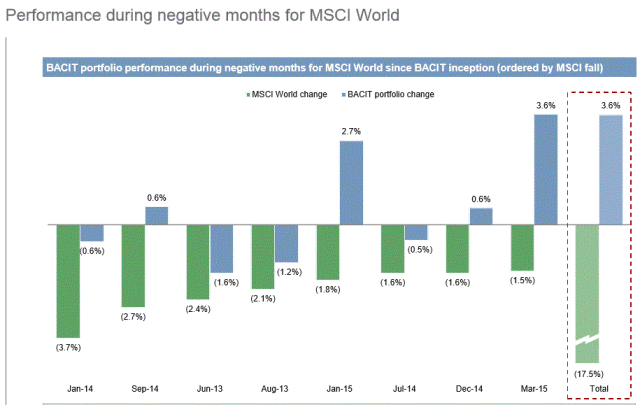There is not much in the City that does not involve generous remuneration for all involved, but the Battle Against Cancer Investment Trust (BACIT) is one rare example. This is a fund of funds that, rather than collecting different types and layers of fees for its managers, waives one layer of fees completely and donates the other to the Institute of Cancer Research and various other charities. I must admit to being prone to moments of cynicism, but this is a venture that I find it difficult not to admire.
How it works
A fund of funds, for anyone who has managed to avoid encountering them, is a vehicle that removes the onus of selecting funds and monitoring their performance from investors. As anyone who has perused TD Waterhouse’s bewildering range of unit trusts will know, picking and monitoring these things is as at least as difficult as investing money directly yourself. What percentage should you put in bonds, should you go for an absolute bond fund or a government bond fund, should you have small cap or value equities, international or emerging etc. etc? The FOF structure removes this headache at a cost–namely, a second layer of fees you must pay.
In addition to paying the fund managers, as you normally would, in a FOF you must also pay your FOF manager for their work in selecting and monitoring those managers. Despite the attractions of this one-stop-shop concept, these fees can make it difficult for even the best managers to deliver the returns that their investors deserve. It is like attempting to run a marathon with four small but good quality bricks tied around your waist.
BACIT (Battle Against Cancer Investment Trust) is a FOF but with a big difference. Firstly, the underlying fund managers waive their management and performance fees entirely. Secondly the management and performance fees that would normally go to the FOF manager are instead donated 50% to the Institute of Cancer Research and 50% to a parcel of charities selected by the Trust’s investors. These charities include Alzheimer’s Research UK, Marie Curie Cancer Centre, Scope, and the NSPCC (you can see the full list on their website). Furthermore, the Trust will invest up to 1% every year in drug development projects supported by the ICR or its subsidiaries that have the potential for commercial development.
The Cast of Characters
BACIT is being run by some very heavyweight City players. Here is a brief rundown of some of the names that I recognise:
- Jeremy Tigue, who has run the esteemed F&C trust quite safely for the thick end of twenty years without either suffering the indignity of embarrassing discounts or attracting vocal and opinionated activist investors.
- Tom Henderson, a former portfolio manager at the highly successful Moore Capital and son of the former Chairman of the ICR. Henderson learned his trade at that rough old workhouse Cazenove & Co.
- John Moulton is currently running private equity group Better Capital and was previously the considerable brain behind Alchemy Partners. Always worth paying attention to on those rare occasions he surfaces to fire darts at imbecile politicians.
- John Chatfeild-Roberts who, as head of multi-manager funds at Jupiter, has spent a lot of his career proving that–in the right hands–the tricky FOF model can work.
- Greg Coffey, another Moore Capital alumnus, Coffey also spent time at GLG Partners. Known to the financial media as the “Wizard of Oz”, Coffey has long been considered a star of the hedge fund world. Looks like a guitarist, rather than a numbers man.
Performance
BACIT states that its target return is an annualised 10-15% on its IPO price (100p). To me, that looks ambitious in the extreme and I would not invest with the remotest expectation of achieving those returns. Instead, if it captured a decent portion of the market upside and not too much of the downside while beating inflation, steadily growing its NAV and increasing its donations, then it would be more than earning its keep.
So how has it done? Well since inception (only October 2012, in fairness), BACIT has returned 30%, or 11.5% annualised. Pretty good, although credit must be withheld until the market turns; we will see then what stuff ’tis made of, or, it is only when the tide goes out that you can see who has been swimming naked, as the man says.
As per the Charities link on the website, BACIT donated £3.1 million pounds to its nominated charities for the year ended March 2014. In addition, last December BACIT made a £20m commitment to the CRT Pioneer Fund, which has the ambition to become Europe’s largest oncology fund. It reports its next year end results on 7 July, and so the latest donation figure will be available then.
Srtategies
It was a surprise to me, when I drilled down into what makes up this fund, just how complicated and obscure some of its strategies are. I would have expected that a lot of the potential investors in this fund would be people who were far from au fait with the latest trends in convertible arbitrage or the like and would actually be put off when they realised just how the trust is going to be generating its returns. That said, Tom Henderson and whoever else was responsible for setting this up must have considered which strategies they sincerely believed would be most likely to generate the capital growth required and the fund’s holdings indicate their conclusion. So, I say let them get on with it and then we can all look back and be wise one way or the other in five years time. Anyway, what does it have?
Well its strategies are as follows (taken from the investors’ presentation from their website):
As I mentioned, this shows how far it is from a vanilla equity fund. Two of the biggest strategies are Macro and Equity Hedge, which is hedge fundery in its purest and most traditional form. The benefit of these sorts of strategies is that they will provide genuine diversification to basic, noddy equity investors (like me) because the performance of the fund should be different to the main indexes, something that will be welcome at times of sharp market falls. This has–so far–been borne out by performance during negative market months:
Of course carefully protecting your NAV means nothing if your fellow investors go ahead and panic regardless, dumping all their BACIT shares and causing the discount to open up like a yawning chasm (as can happen to even the finest trust). But that is life with investment trusts and, for people who take the trouble to follow the underlying performance and make sure they always have enough cash on hand so that they will never be forced sellers, it should be an opportunity not a cost. I.e. Just stump up to add more when the discount is wide.
And speaking of discounts, one didn’t exist until recently but, with the latest NAV at 125.05, the premium has been virtually eroded and the shares now look to be selling at a fair price for new investors (127p). Here is a chart showing the movement of the premium/discount since inception:
I wouldn’t ever consider paying a premium for an investment trust, no matter how well it was run, so I am pleased to see that the premium no longer exists. Personal Assets Trust is a model for me in that respect because they issue and buy back shares on an on-going basis to ensure that departing investors always receive a fair price for their holdings.
Holdings
BACIT has approximately 30 investments. I investigated a few of these to see if I could find out what they do and how they do it. Here are some of my findings:
- Maga Small Companies Fund
This is a Contintental European Small Cap long/short fund that launched in April 2004. It is run by Otus Capital, which looks to be an exceptionally small boutique that was founded by Andrew Gibbs. According to the LSE the EUR NAV of the fund is +147% over 10 years. - Sinfonietta Fund
An Asia-based trading fund, founded by David Baran and Kazuhiko Shibata. I can’t find reliable performance figures, but this article suggest that it made +35% in 2012. In 2013, however, the music stopped with a -10% dip (sorry). - Majedie UK Equity Fund
The flagship fund of the Majedie group, this is run by a quintet of managers and has produced a remarkable c. 390% total return since inception (2003). Rather boringly, it appears to hold a lot of British and European telecomm companies (both mobile and fixed-line, in case you are remotely interested). It is also substantially underweight some of my personal favourites: Diageo, Reckitt, and British American Tobacco. - Chenavari Long Short Corporate Credit Fund
A “long short corporate credit fund” is exactly the sort of thing I would not normally touch with an exceptionally lengthy barge pole, but as in a chocolate box there must always be room for those coffee and plain chocolates, in a fund of funds I suppose you must expect a bit of corporate credit. A quick look online reveals that this one has somehow returned over 13% a year. I won’t even attempt to find out how (prodigious trading with a dash of leverage, I expect), but like every other manager here they are providing their service for nothing and seem to be the cream of their particular crop.
I think BACIT is a brilliant idea and I hope it succeeds and generates growing donations for many years to come. If it is trading at NAV come pay day, then I will put my money where my mouth is.
Disclosure: Not (yet) long BACT
Disclaimer: This post is not a recommendation to either buy or sell. Please consult your investment advisor.



